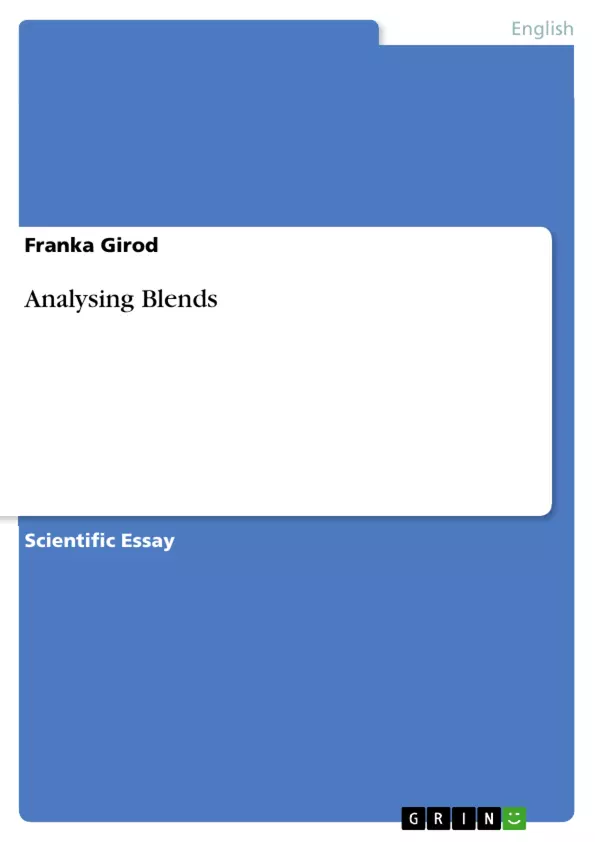“You see it’s like a portmanteau – there are two meanings packed up into one word”
(Carroll 2002:186). That is what Humpty Dumpty told Alice about a poem, where
words were mixed together out of other words. But not only in Lewis Carroll’s
“Through the Looking-Glass” words like these occur. If you take a newspaper, you
will find a lot of mixtures. One of the most famous of the last years are names like
Brangelina oder Bennifer, where popular couples were shortened to one name.
These names caught the attention of readers and led to an increasing usage. Some
words are part of our language and a division into the original parts becomes difficult.
Take brunch as an example. Most people would describe it as a second breakfast,
but would they think of a mixture of breakfast and lunch in the first place?
Portmanteau words, as Humpty Dumpty calls them, in Linguistics are known as
blends. It is a part of morphology which is often discussed, because there are a lot of
contradictions. The question arises if there are general rules which can be used to
form blends and if there are major categories of blends.
The paper will show the most important characteristics of blends and their structure.
Furthermore it tries to find some answers to the above mentioned questions and
proves or disproves generalisations. With the help of a survey the characteristics
shall be looked at in a critical way.
Inhaltsverzeichnis (Table of Contents)
- Introduction
- Characteristics
- Definition
- Meaning
- Structure
- Survey
- Analyses
- Conclusion of the Survey
- Conclusion
Zielsetzung und Themenschwerpunkte (Objectives and Key Themes)
This paper aims to analyze the characteristics of blends, a linguistic phenomenon where words are combined to form a new word. The paper will explore the definition, meaning, and structure of blends, attempting to uncover general rules governing their formation and categorization. It will also examine the relationship between blends and other linguistic structures, such as compound nouns and acronyms.- Definition and Characteristics of Blends
- The Structure and Formation of Blends
- Relationship between Blends and Other Linguistic Phenomena
- Survey of Blends and Their Characteristics
- Analysis of Blends and Their Structure
Zusammenfassung der Kapitel (Chapter Summaries)
Introduction
This chapter introduces the concept of blends, drawing a parallel to the "portmanteau" concept in Lewis Carroll's "Through the Looking-Glass." It explores the phenomenon of blend formation in various contexts, from popular culture to everyday language, highlighting the complexities and challenges of categorizing and analyzing blends.Characteristics
Definition
This section defines blends as words formed by combining two or more words, often deleting material from the source words. It explores the similarities and differences between blends and other linguistic structures like compound nouns and acronyms, discussing the debatable inclusion of blends within the domain of morphology.Meaning
This section categorizes blends based on their meaning. The author distinguishes between blends where one part modifies the other and those where both parts contribute equally to the meaning.Structure
This section delves into the structural characteristics of blends, focusing on the generalized rule of combining the first part of the first word with the second part of the second word (AB + CD → AD). The chapter discusses the interplay of syllabic structure and blending rules, highlighting exceptions and variations in the structure of blends.Survey
This section presents a survey of blends, analyzing their characteristics and structure in a critical manner. It aims to gather data and evidence to support or refute the generalizations made in the previous sections.Conclusion
This chapter, excluded from this preview to avoid spoilers, will likely synthesize the findings of the paper, offering concluding remarks and further research directions.Schlüsselwörter (Keywords)
The main keywords and focus topics of this paper include blends, morphology, linguistics, compound nouns, acronyms, structure, meaning, survey, analysis, and language. The paper explores the characteristics of blends as a linguistic phenomenon, examining their formation, structure, and relationship to other linguistic structures.- Quote paper
- Franka Girod (Author), 2008, Analysing Blends, Munich, GRIN Verlag, https://www.grin.com/document/150856



